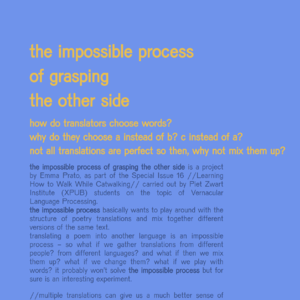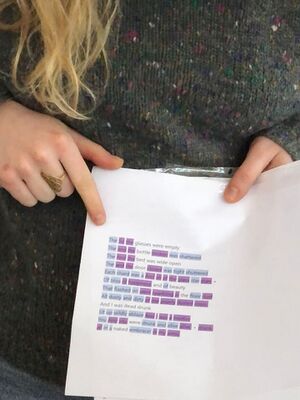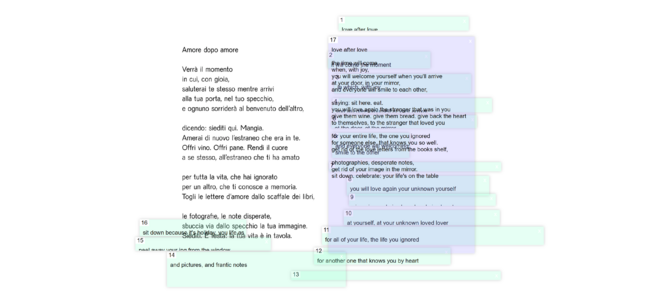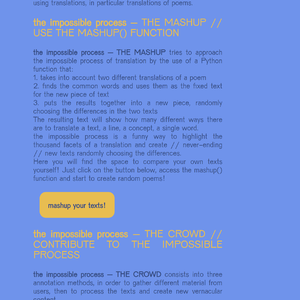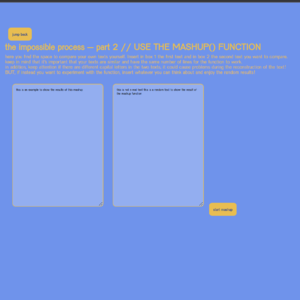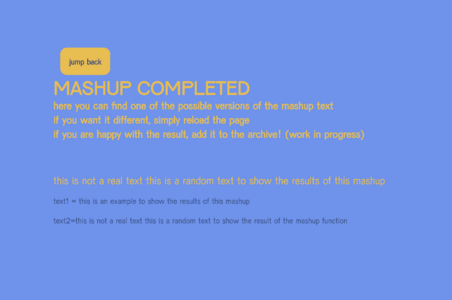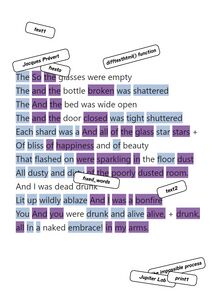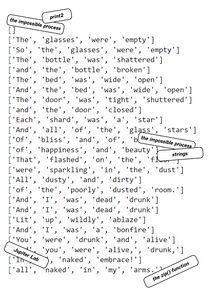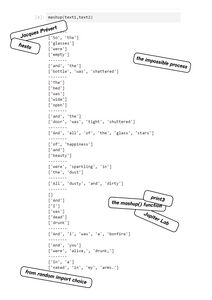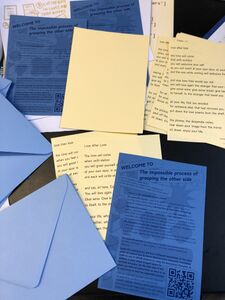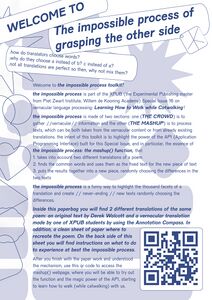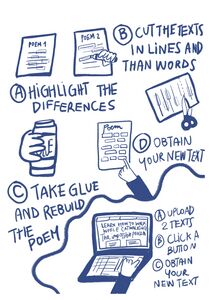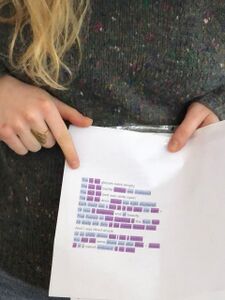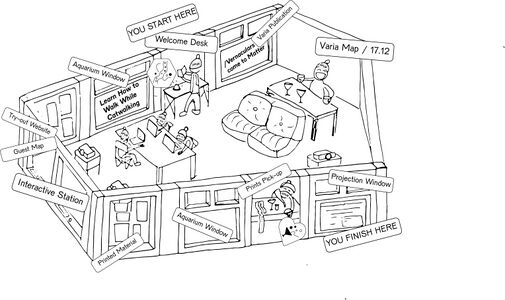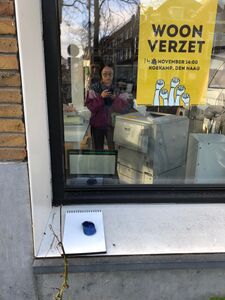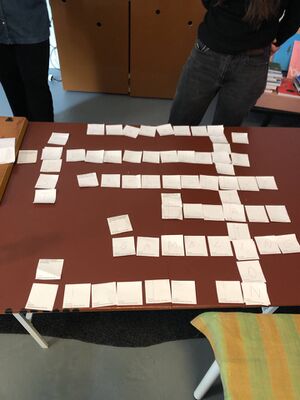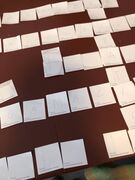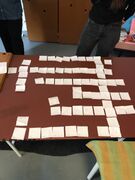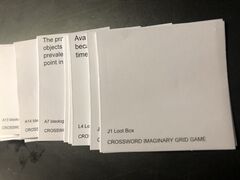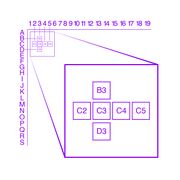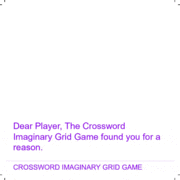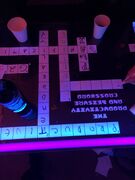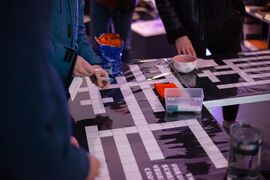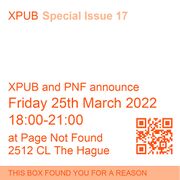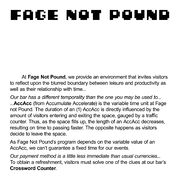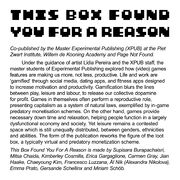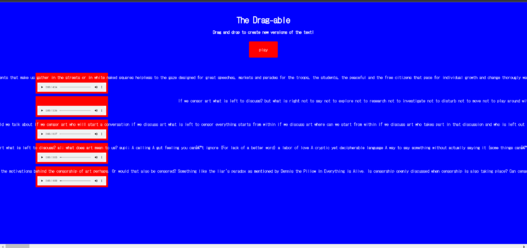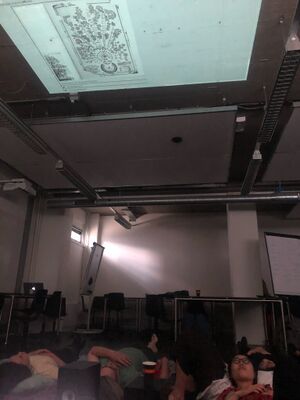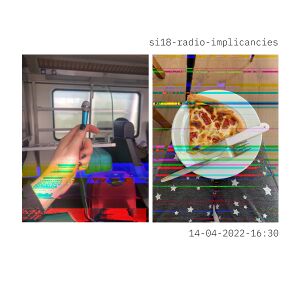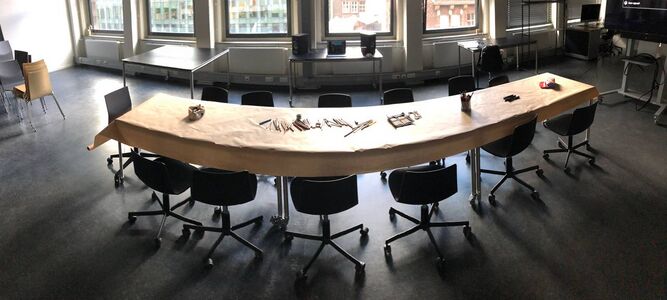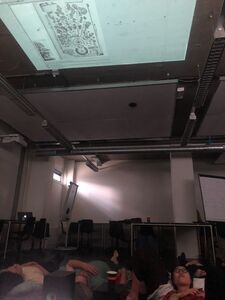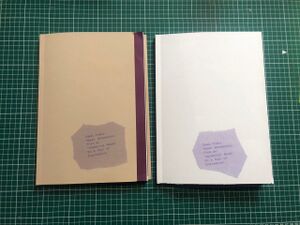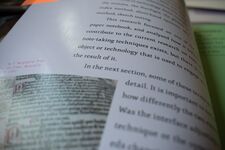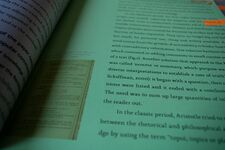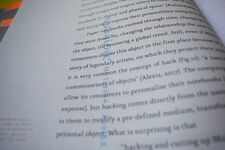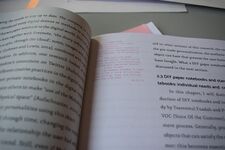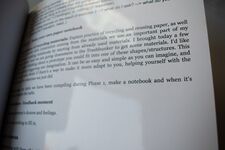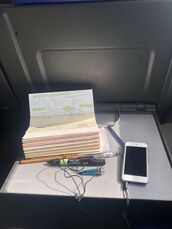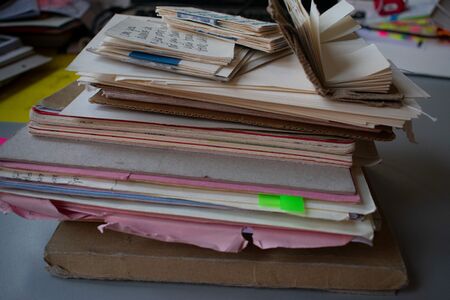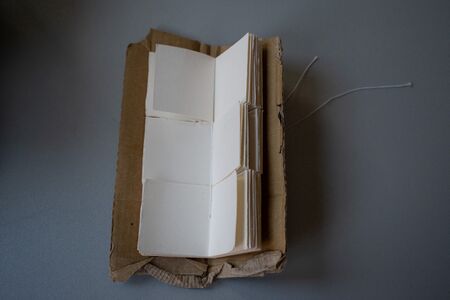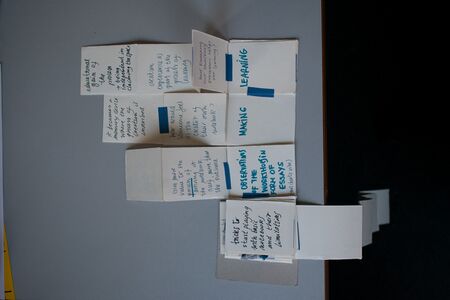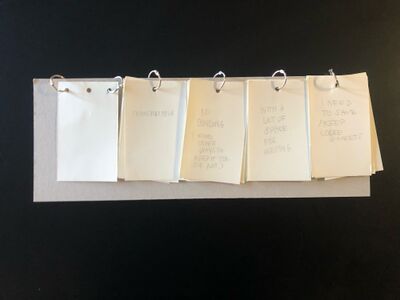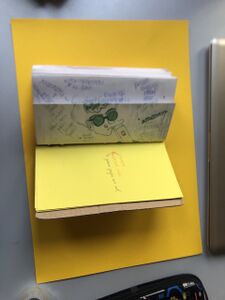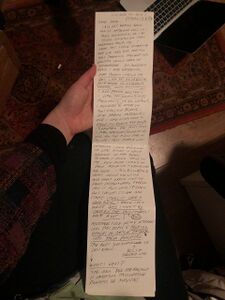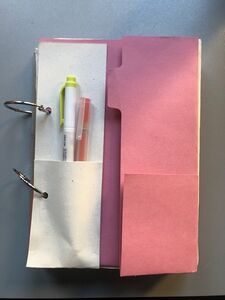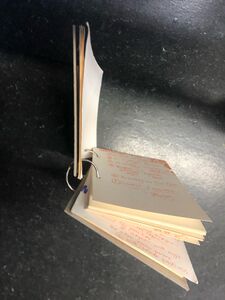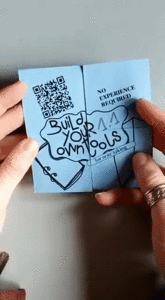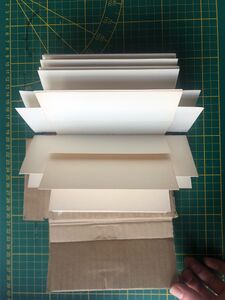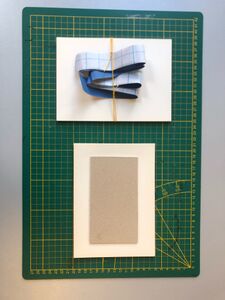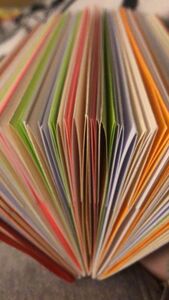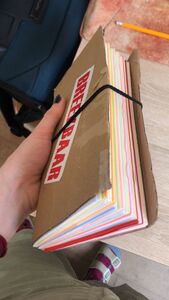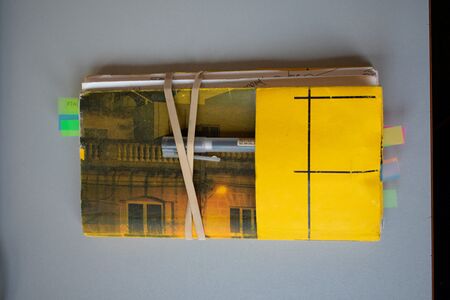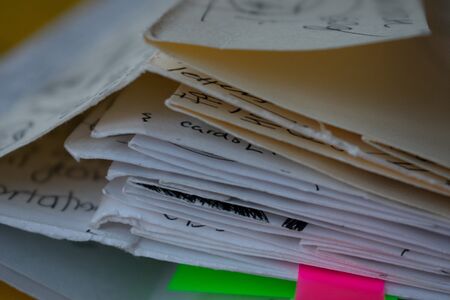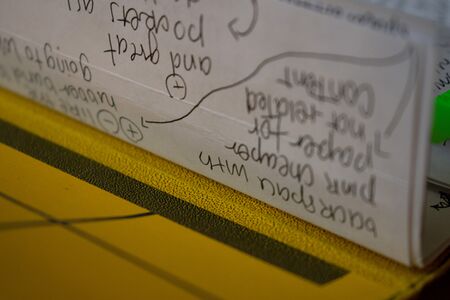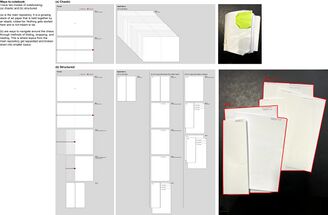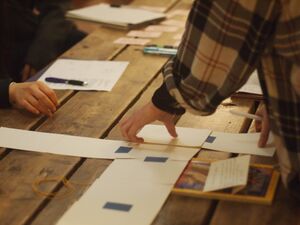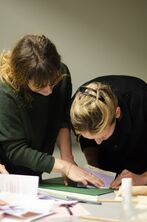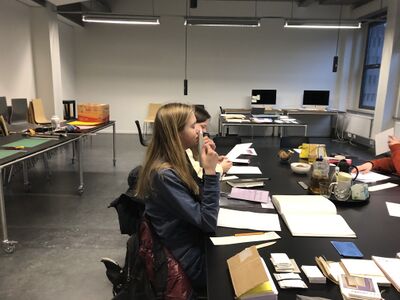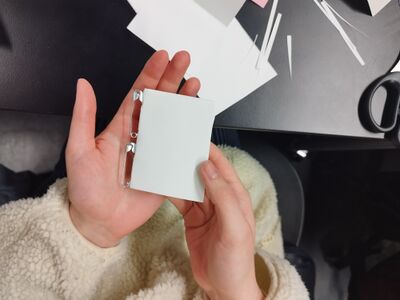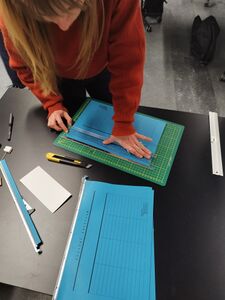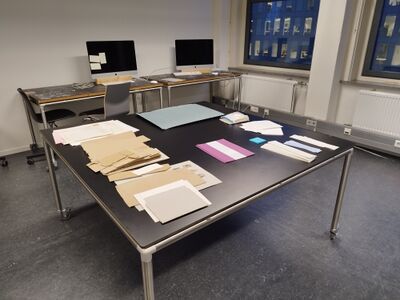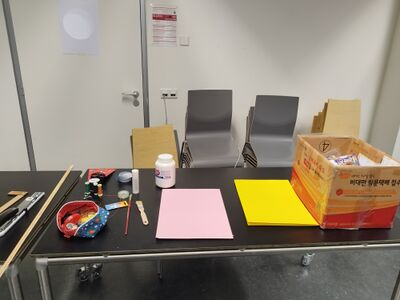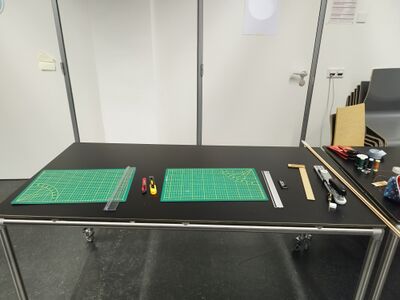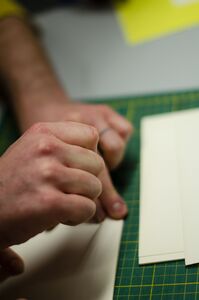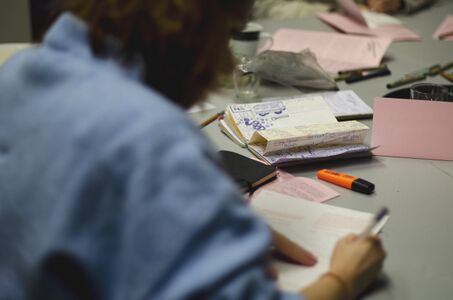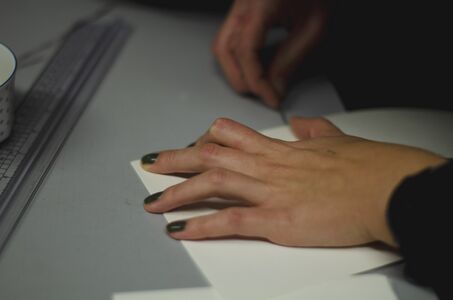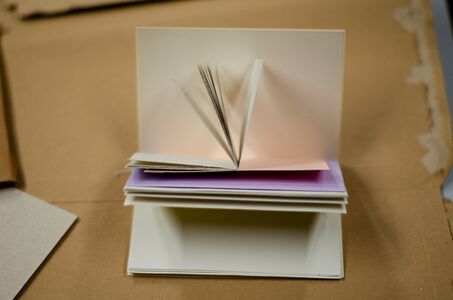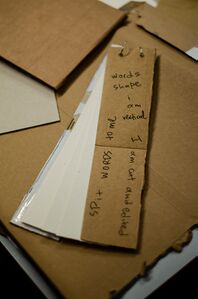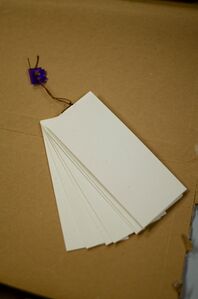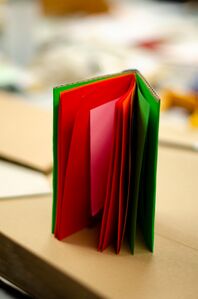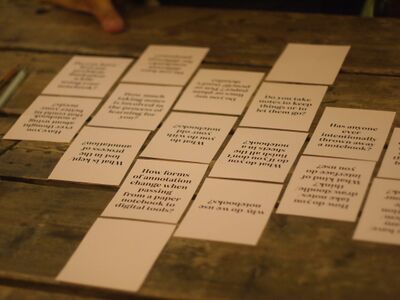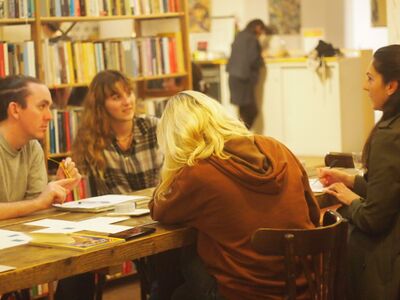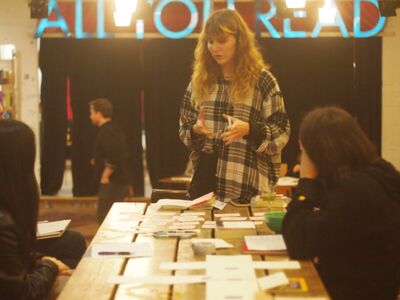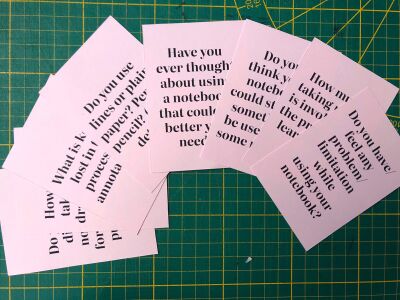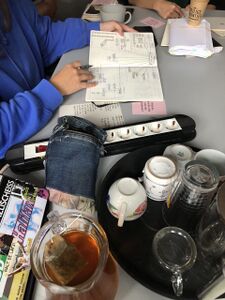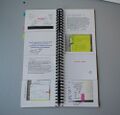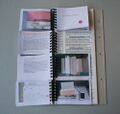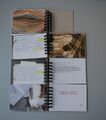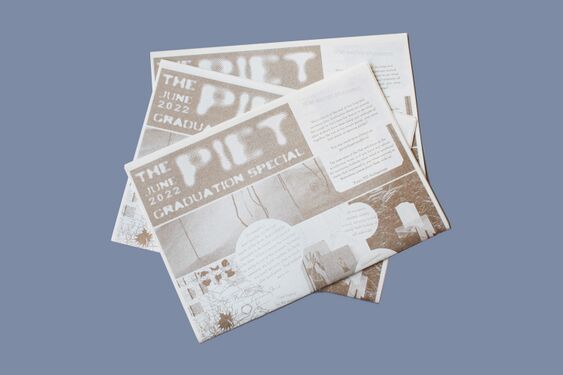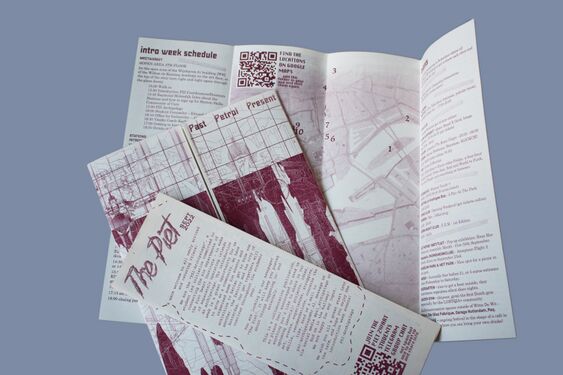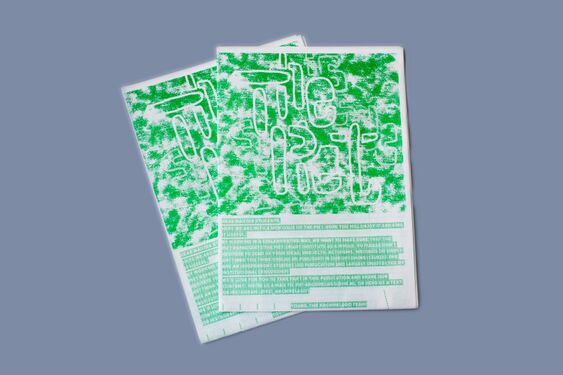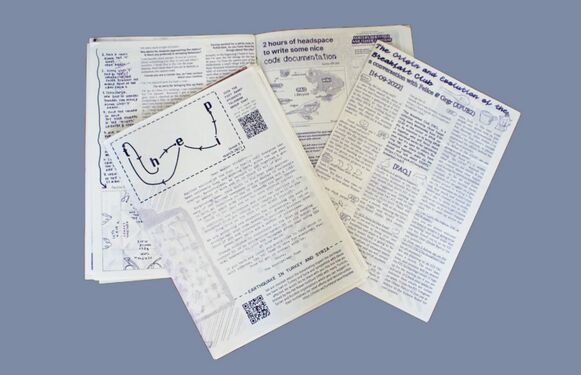User:FLEM/Final presentation: Difference between revisions
| Line 306: | Line 306: | ||
=== The publication and plans for the grad show === | === The publication and plans for the grad show === | ||
GENERAL CONTEXT OF THE AIM: the final PROJECT will consist in 2 parts: | |||
A) A modular notebook that alternates info (on different features of notebooks, where to find materials etc), activities to make notebooks, and the invitation to reflect on the notebook practice. | |||
This is about '''involving others,''' to make notebooks' making more accessible/a tool of expression | |||
B) How to publish a notebook making practice? How to make a notebook public? (and accessible by others) | |||
This is about '''documenting, storytelling, experiencing.''' | |||
ps:// ''accessible'' means: able to be reached or easily obtained; possible to approach, enter, or use; easy to understand or enjoy. | |||
=== 01.05.23 === | |||
==== The printed publication ==== | ==== The printed publication ==== | ||
Documentation: [[User:FLEM/noteboox]] | Documentation: [[User:FLEM/noteboox]] | ||
Excerpt from the publication: | |||
''Dear soon-to-be-maker,'' | ''Dear soon-to-be-maker,'' | ||
'' | ''(...) The result of my research is a kick-starter kit, or a game, or a (note-)book, to start questioning and experimenting with the creation of notebooks.'' | ||
''My aim was to create an object that could be used, and not only consumed. Thus, I would like you, my reader, my user, to become a maker through the use of this kit. I hope you will enjoy the journey through my texts, my prototypes, my questions and my answers. I hope you will find your way in the practice of making notebooks and you will explore the feelings of creating your own tool.'' | ''My aim was to create an object that could be used, and not only consumed. Thus, I would like you, my reader, my user, to become a maker through the use of this kit. I hope you will enjoy the journey through my texts, my prototypes, my questions and my answers. I hope you will find your way in the practice of making notebooks and you will explore the feelings of creating your own tool.'' | ||
''I made many different choices in the creation of this work, and I would like to share them with you. Therefore, if you are interested in knowing more, go on reading!'' | ''I made many different choices in the creation of this work, and I would like to share them with you. Therefore, if you are interested in knowing more, go on reading!'' | ||
''' | '''WHY''' | ||
* Starting from the question: '''"how can I edit and present all of this material I gathered in the last year?"''' I wanted to share all the little discoveries I made and what I learnt with others, as well as inviting a hands-on approach. | * Starting from the question: '''"how can I edit and present all of this material I gathered in the last year?"''' I wanted to share all the little discoveries I made and what I learnt with others, as well as inviting a hands-on approach. | ||
* '''why notebooks?''' 22.09.22 I have always been interested in the materiality of objects and their touch and how to build things myself. A lot is also about subjectivity and modularity: I am fascinated by the fact that, also a publication, for example, can be created in a way that every person that uses it can react in their own way. I think it's a lot about disrupting known formats and ideas. | * '''why notebooks?''' 22.09.22 I have always been interested in the materiality of objects and their touch and how to build things myself. A lot is also about subjectivity and modularity: I am fascinated by the fact that, also a publication, for example, can be created in a way that every person that uses it can react in their own way. I think it's a lot about disrupting known formats and ideas. | ||
*'''what i would like is''' 18.04.23 I would like to create (active) makers, not consumers. The final outcome needs to be something to be used to make, not only to receive/consume. I want the users of this work to participate in the act of making notebooks against capitalism and commodity practices. I want to expand the spaces of this medium. | *'''what i would like is''' 18.04.23 I would like to create (active) makers, not consumers. The final outcome needs to be something to be used to make, not only to receive/consume. I want the users of this work to participate in the act of making notebooks against capitalism and commodity practices. I want to expand the spaces of this medium. | ||
*I would like this research to be a sort of manifesto for a general context but using the notebook as a metaphor: Who are you? How does your brain work? How do your ideas come along? What are your needs from a tool that society provides in a standardised form? It is not only about making a notebook, it is how making a notebook will put you in the position of questioning who you are and the objects you use, why you use them and how something made by you for you could look and feel like. | |||
'''CONTENT''' | '''CONTENT''' | ||
* The content | * The goal was to create a kit for making notebooks that could be read, but also used to practically make notebooks. The content originates from my reflections and both digital and handwritten notes. I used my existing collection of texts, conversations, images, thoughts. | ||
'''SCRIPT & DESIGN''' | '''SCRIPT & DESIGN''' | ||
* A Python script was developed for this project to embrace alternative methods for design; approach to web-to-print. | |||
* The script generates a different positioning for each card every time it is run. | |||
* Different PDFs can be generated with each reload, creating distinct card arrangements. | |||
* Modularity is emphasized as the connections between cards can vary based on their positions. | |||
* The intention is to offer an individual experience and encourage users to create their own unique connections. | |||
* Tha cards are part of different categories, differentiated by different colours and headlines for easy recognition. | |||
* The cards can be use individually but the content can stand alone too. | |||
'''PRODUCTION CHOICES''' | |||
* The goal was to create a kit for making notebooks that can be read and used practically. | |||
* The prototypes created during the research process shaped the material concept of the notebook. | |||
* The first prototype is an adjustable and editable notebook inspired by index cards, allowing for smaller, standalone content. | |||
* The concept of modularity led to the creation of the triad notebook with three browsable rows for recreating connections. | |||
* Customizability is a key aspect, allowing users to interact with the notebook and participate in its use and creation. | |||
* The spine of the notebook enables 360-degree rotation, connecting content between rows and experimenting with different structures. | |||
* Users can mix their own pages with the provided ones or remove all the provided pages to fill in with their own, allowing for the creation of new notebooks. The pages can also be used as cards without the spine, raising questions about the definition of a notebook. | |||
* The back cardboard and the intro-texts spread at the back are made from waste/leftovers from the studio. | |||
* The publication is printed on A4 layout to minimize paper waste. | |||
'''Prototypes experiments of the final publication'''<gallery mode="slideshow"> | '''Prototypes experiments of the final publication'''<gallery mode="slideshow"> | ||
File:First prototype.jpg|The first printed prototype | File:First prototype.jpg|The first printed prototype | ||
| Line 343: | Line 367: | ||
File:Final protoype.jpg|The final printed prototype | File:Final protoype.jpg|The final printed prototype | ||
File:Final protoype cover.jpg|The cover of the final printed prototype | File:Final protoype cover.jpg|The cover of the final printed prototype | ||
</gallery> | </gallery>'''The costs of production label''' | ||
'''for one copy''' | |||
* inside paper (tot. 23 euros x 250 sheets) = 0,092 x 16 sheets = 1,472 euros | |||
* cover paper (1,25 per sheet) = 0,623 euros | |||
* spine = 0,649 euros | |||
* print (insides) = 2,88 euros (from hr printers, so I did not pay for them) | |||
* print (cover) = 0,25 euros | |||
* print (intro-texts) = 0,88 euros | |||
* making holes and attach spine = 0 euros | |||
'''total of the costs of productions for one copy''' = 6,754 euros = '''6,80 euros''' | |||
==== The website ==== | ==== The website ==== | ||
The main reason of the existence of the screen version is to keep the work available after the prints are finished. therefore, i'd like that everyone could press the print button and get a printed version of the cards (that can be put together as a book but also just left as cards without holes). on the other side, it would be nice to have something happening on the website: | |||
==== The grad show ==== | ==== The grad show ==== | ||
Revision as of 14:07, 10 June 2023
Special issue 16
My main project during the special issue 16 was the impossible process project.
Wiki research & documentation: poems translations.
Website: https://hub.xpub.nl/soupboat/theimpossibleprocess/
the impossible process of grasping the other side
the impossible process of grasping the other side is a project by Emma Prato, as part of the Special Issue 16 //Learning How to Walk While Catwalking// carried out by Piet Zwart Institute (XPUB) students on the topic of Vernacular Language Processing.
the impossible process is about:
- playing around with the structure of poetry translations and mix together different versions of the same text, through a Python function.
- multiple translations can give us a much better sense of the poem than a single translation can, so that even if we can’t read the poem in the original language, we can come closer to that experience.
the impossible process is made of two sections:
- one (THE CROWD) is to gather //vernacular// information
- the other (THE MASHUP) is to process texts, which can be both taken from the vernacular content or from already existing translations.
- The poetry ARCHIVE will showcase the results, uploaded automatically after mashing up (json file).
Connection with second year project
I analysed patterns and disrupted common structures to create new versions of texts.
I created a prototype of linguistic patterns and the impossible project website, a tool for vernacular translations.
I used the annotation system created for Special Issue 16 to gather translations from users.
The final publication for the public to interact and understand the Python function I created has been the "letter bag", an activity that would reproduce what happens in the function and ask the user to do it by hand.
In recalls what I am making in the Second Year project with the following question: what happens when you mirror digital interactions into a physical movement? In both cases, I reckon, it is a very interesting tool to make people who know nothing about coding, what is happening. I started to understand how python scripts work and started making some websites to try out things.
Contribution/groups
- I was part of ADMIN TEAM: creating the meetings, schedules, keeping track of the work.
- I was part of LAUNCH TEAM: event coordination, organisation and user experience for the launch day.
- I was part of FRONT-END TEAM: support during the creation of front-end of the website, advices and considerations.
- Content group: research on python function, set up, layout and flask for website of “the impossible process”; prints and booklet for the same project. In addition, general research for the “vernacular maps” group.
Other things
My notes documentation: User:FLEM/1.1
- collabweek3
- Station Skill html
- text waving
- transcription
- smart textile station skill
- wood station skill
- jacques prévert poems
Gallery
Special issue 17
The crossword experience
The crossword experience:
- is a reference to the crosswords as a game
- gives an overview of the productive play glossary, that will be found inside the loot box and represents the research part of our project.
- The post-its/squared pieces of paper definitions act as a go-between the content and the players, and obviously share the values and reasons why post-its have been chosen as the mean for this project.
- The idea emerged to reflect on some of our main topics (slow-thinking, delayed rewarding, gamification processes, competition, individuality, productive environment) in a gamified way.
- Takes part in the collective publication and into the launch day, offering two different ways of interaction
During the event, he player will:
1. Complete a puzzle to create a word, therefore to play a game to obtain a drink, instead of having a need and satisfying it immediately. It is a critic of loot boxes philosophy and serves to slow the pace down because the players can't get the drink immediately (delayed-reward and slow-thinking).
2. By the end of the event, the public will have produced a collective work, a big crossword made by everyone in the room. It's a way to create interaction and criticise the video games world that produces a lot of individuality and competition. Instead, this method invites the player to embrace collectivity and inclusivity.
Wiki research & documentation: User:FLEM/Crosswords
Connection with second year project
I tried to involve a public, to explain more than what seems like needed, I had in mind the idea that our public should understand
My intent was that of translating one form of research into an activity/event.
I like the idea that an audience can interact with what is shown to them: everyone has different learning methodologies, and it’s our job to put everyone in a situation where they can get the best out of the experience.
Contribution/groups
- I researched and polished the glossary of productive play to transform it into a usable and understandable game for the public. A way to access our theoretical research through the use of gamification.
- The result was presented inside the box as “The Crossword Imaginary Grid Game” .
- The result was adapted to be presented during the launch as “the Fage Not Pound Bar Counter”.
- I was part of LAUNCH group:
- Price of the box.
- Texts for the launch.
- Documentation and presentation of the work.
- Prints and plotting.
- name tags.
- Plexiglas letter game for the launch.
Other things
My notes documentation: User:FLEM/1.2
- a box in a box in a box - 16_02_22 (with G&Carmen)
- Re-writing Station Skill
- Station Skill Java
- calligraphy and typography station skills
- the social side of games
- playing cards
- Glossary_of_productive_play
Gallery
Special issue 18
The SI18 structure gave more space for our personal interests, actions and reactions.
- We experimented with annotation systems, annotation methods and distributive practices, which grasped my interest quite a lot.
- Miriam and I, for the week02release, produced an instructional piece on “how to make sound”.
- The editorial proposals I have been part of are also significant: Week5release was about collective writing, a practice that I find deeply interesting, and I was also interested in the idea of distributive practice.
- Transcription methods that feed the need of experimenting with text (see Libretto of week3).
- I worked on the Draggable, another online tool to mess up with texts (and audio in this case).
- The other editorial proposal was about folder and content nesting: the activation by users is essential for the functionality of the tool we curated for this release. The result was a collective process: the result will be obtained only if others will actively participate.
I enjoyed creating small weekly prototypes, and the possibility to try new things proposed by other people: the moment when I received the proposals and had to discover what it could be about. Then, seeing how my brain starts to work and looks for inventive solutions to learn and to try out different methods or tools. I am happy how I managed, as a caretaker, to go deeper into my personal interests, to see how contributors reacted to the proposals (7&5) and the possibility that my ideas will change after other people experimented with them or created their own way out of it. I am pleased to see how we could influence each other and evolve in very different ways with every method we've been using and the person we were working with. It all gave me the feeling of collective work.
Contribution/groups
Wiki research & documentation:
- week 02 ---> https://hub.xpub.nl/soupboat/SI18/02/recordings/your%20personal%20guide%20to%20making%20sound.mp3
- week 03 ---> audio file: ACT1 libretto: Within an entangled state
- week 05 ---> https://hub.xpub.nl/soupboat/~flem/FIVE_nested_narratives_active_listening.mp4 instrument: voiced drum machine; audio piece: what-is-right-not-to.mp3 text: what-is-right-not-to.txt ---> The Drag-able
Side things
My notes documentation: User:FLEM/1.3
Gallery
Second Year
wikis:
Research & Thesis
Abstract: Paper Notebooks: From an Industrial Model to a Tool of Expression is an ongoing research project that attempts to understand how the structure, shape and functionality of a paper notebook can influence the way we take notes as well as the frequency and efficiency of use. The thesis uses theoretical research and practical methodologies to analyse paper notebooks, to discover how different prompts and activities can change the users’ mindset and consciousness, while inviting them to produce personalised DIY notebooks in their personal practice.
- I started questioning my notebook's practice and tried to build a new paper device that would satisfy better the needs of my brain in that moment. To get there I asked myself what were the problems in the device I was using and how changing something small could already improve my use of the notebook.
- I then wondered: Why are we all using a device with the same structure? And what impact does it have on our learning, thinking and living, as well as on the imaginary of self? And how creating our personal tools would help users to understand better themselves and their needs?
- So my research question became: How can I, through research and explorative sessions, discover more about the topic and create a generative structure that can be interpreted by every person in their own way to promote creativity and self-expression?
- The thesis is a report of my practice: informed through theoretical research and references that fed the research method section that is part of the body of the thesis. It charts a historical and contextual overview on notebooks, with a focus on the importance of making and the physical act of taking notes on paper notebooks. The text then presents the development of the project through the different methods and the findings that will lead to the creation of a physical outcome. [the spatial memory A process takes place when we take notes and the type of interface we use to do it makes a difference: “The hippocampus is crucially involved not only in memory encoding and retrieval processes but also in spatial memory itself” (Umejima et al., 2021). (..) Throughout my research, I discovered how much it is important, for recovery and reviewing reasons, where I specifically write words or sentences. Recently, I found myself scared of forgetting because the pages of an unfitting notebook did not allow a proper instinctive positioning of the content while taking notes.]
- The final outcome took the shape of a guide or kick-starter kit to help others to analyse their own practice and to start questioning it, as well as to encourage a hands-on approach.
The methods
1. My personal notebook process
It consists in the creation of different prototypes to analyse and question my use of notebooks and to discover how to modify them to adjust them to my needs.
- I finished my notebook and started a plan to build up a new one.
- I then produced different prototypes to play around with the concept of adapting notebooks to my needs.
- I tried to distribute notebooks prototypes around and realised how it was not possible that I would create the notebooks My classmates started experimenting with their own and I saw what was happening was much more interesting than me looking for a perfect notebook, that obviously does not exist as our needs change depending on who we are and in which situation we need the object.
- Documentation: User:FLEM/Notebook
- my personal notebook process
2. Gathering and analysing the work of other users
The aim was to understand how others approach the same process.
- Supi and Erica have been my case studies: throughout the year I could follow their choices and reasoning on their use of notebooks.
- Supi had a very strong connection with the tool, her Muji pen
- Erica instead, had a very strong connection for time-based notebooks and scattered notes that come together when needed
- Their work was essential to demonstrate that others can go through this process by themselves.
- Documentation: User:FLEM/Analysis of sessions#personal notebook research from others
3. Discussion groups (or Preparatory Sessions)
They helped me to collect opinions through conversation and questions.
- I organised three preparatory sessions in which I brought up specific questions and discussed them together with the participants.
- The main aim was to discover if notebooks are part of their lives and if I could use this specific object to incite a certain type of thoughts and associations to promote self-expression and creativity.
- New questions and ideas arose
- Documentation: User:FLEM/Analysis of sessions#Preparatory sessions
4. The Collaborative Explorative Sessions (C.E.S.)
- A collaborative playground to experiment with a collection of exercises together with the workshop participants.
- I created the C.E.S. through the knowledge acquired in the process and specifically thanks to the first three methods included in the research, as well as inspired by Generative Design Research, which includes the end user in the design process (Sanders and Stappers, 2014).
- My aim was to experiment with different activities to help participants to imagine the iterative process to arrive to a notebook.
- It was important to transform my questions into practice.
- The session and the final toolkit are starting points/initialiser for them to test scenarios to see what works better (the CES are for me, the toolkit is for the people, made by me as a researcher together with the participants) --> it is different if I organise the sessions for my research's purposes
Documentation: User:FLEM/Analysis of sessions#C.E.S.
The publication and plans for the grad show
GENERAL CONTEXT OF THE AIM: the final PROJECT will consist in 2 parts:
A) A modular notebook that alternates info (on different features of notebooks, where to find materials etc), activities to make notebooks, and the invitation to reflect on the notebook practice.
This is about involving others, to make notebooks' making more accessible/a tool of expression
B) How to publish a notebook making practice? How to make a notebook public? (and accessible by others)
This is about documenting, storytelling, experiencing.
ps:// accessible means: able to be reached or easily obtained; possible to approach, enter, or use; easy to understand or enjoy.
01.05.23
The printed publication
Documentation: User:FLEM/noteboox
Excerpt from the publication:
Dear soon-to-be-maker,
(...) The result of my research is a kick-starter kit, or a game, or a (note-)book, to start questioning and experimenting with the creation of notebooks.
My aim was to create an object that could be used, and not only consumed. Thus, I would like you, my reader, my user, to become a maker through the use of this kit. I hope you will enjoy the journey through my texts, my prototypes, my questions and my answers. I hope you will find your way in the practice of making notebooks and you will explore the feelings of creating your own tool.
I made many different choices in the creation of this work, and I would like to share them with you. Therefore, if you are interested in knowing more, go on reading!
WHY
- Starting from the question: "how can I edit and present all of this material I gathered in the last year?" I wanted to share all the little discoveries I made and what I learnt with others, as well as inviting a hands-on approach.
- why notebooks? 22.09.22 I have always been interested in the materiality of objects and their touch and how to build things myself. A lot is also about subjectivity and modularity: I am fascinated by the fact that, also a publication, for example, can be created in a way that every person that uses it can react in their own way. I think it's a lot about disrupting known formats and ideas.
- what i would like is 18.04.23 I would like to create (active) makers, not consumers. The final outcome needs to be something to be used to make, not only to receive/consume. I want the users of this work to participate in the act of making notebooks against capitalism and commodity practices. I want to expand the spaces of this medium.
- I would like this research to be a sort of manifesto for a general context but using the notebook as a metaphor: Who are you? How does your brain work? How do your ideas come along? What are your needs from a tool that society provides in a standardised form? It is not only about making a notebook, it is how making a notebook will put you in the position of questioning who you are and the objects you use, why you use them and how something made by you for you could look and feel like.
CONTENT
- The goal was to create a kit for making notebooks that could be read, but also used to practically make notebooks. The content originates from my reflections and both digital and handwritten notes. I used my existing collection of texts, conversations, images, thoughts.
SCRIPT & DESIGN
- A Python script was developed for this project to embrace alternative methods for design; approach to web-to-print.
- The script generates a different positioning for each card every time it is run.
- Different PDFs can be generated with each reload, creating distinct card arrangements.
- Modularity is emphasized as the connections between cards can vary based on their positions.
- The intention is to offer an individual experience and encourage users to create their own unique connections.
- Tha cards are part of different categories, differentiated by different colours and headlines for easy recognition.
- The cards can be use individually but the content can stand alone too.
PRODUCTION CHOICES
- The goal was to create a kit for making notebooks that can be read and used practically.
- The prototypes created during the research process shaped the material concept of the notebook.
- The first prototype is an adjustable and editable notebook inspired by index cards, allowing for smaller, standalone content.
- The concept of modularity led to the creation of the triad notebook with three browsable rows for recreating connections.
- Customizability is a key aspect, allowing users to interact with the notebook and participate in its use and creation.
- The spine of the notebook enables 360-degree rotation, connecting content between rows and experimenting with different structures.
- Users can mix their own pages with the provided ones or remove all the provided pages to fill in with their own, allowing for the creation of new notebooks. The pages can also be used as cards without the spine, raising questions about the definition of a notebook.
- The back cardboard and the intro-texts spread at the back are made from waste/leftovers from the studio.
- The publication is printed on A4 layout to minimize paper waste.
Prototypes experiments of the final publication
The costs of production label
for one copy
- inside paper (tot. 23 euros x 250 sheets) = 0,092 x 16 sheets = 1,472 euros
- cover paper (1,25 per sheet) = 0,623 euros
- spine = 0,649 euros
- print (insides) = 2,88 euros (from hr printers, so I did not pay for them)
- print (cover) = 0,25 euros
- print (intro-texts) = 0,88 euros
- making holes and attach spine = 0 euros
total of the costs of productions for one copy = 6,754 euros = 6,80 euros
The website
The main reason of the existence of the screen version is to keep the work available after the prints are finished. therefore, i'd like that everyone could press the print button and get a printed version of the cards (that can be put together as a book but also just left as cards without holes). on the other side, it would be nice to have something happening on the website:
The grad show
22.05.23
little gift idea
this specific little notebook that i gifted kim and chae for the midwives work showed itself to work for specific activities: writing letters, free-writing, getting rid of thoughts very fast let's say. We discussed in class that we are going to have a shop were we can sell little things and i was thinking about selling them for a *on offer* price as i am making them with 0 expenses as it's all leftover materials. It would be nice maybe, to have a table with them and then other materials so if someone wants they can come and make them. Maybe, i would not even need to prepare them beforehand but bind them directly on the spot in my area and if someone is interested in receiving a little gift to help them to write a lotttttttttt they can get it here. It's also a way to give an example of what you can do with 0 money. And would it be fun or awkward to say if you make it yourself it's for free and if you just want to get it you pay a little for my working time (that it's still very limited). Talking about the price of work, and how people can experiment with this shape and make them a tiny different from my version... mmm i like it, it doesn't have to be a CES, but sort of. And maybe with the making there'll be some chatting and that's all.
A sort of notebook that can be used if you need to write letters, get rid of thoughts, write fast, brainstorm for projects or writing tasks, see what happens. Maybe add the print of the ones I gave chae and kim for context. + comment from mitsa during CES (so narrow make me think i can write down without thinking). If you do not know what to start with, there it is. And in case, you can also gift it to someone!
the grad show shelves team
questions:
- when i can't use a notebook
What interrupts me from using a notebook is that I do not know where to position the sudden ideas or thoughts I have. From this statement, I understand that what I need from the next notebook is to have the possibility to immediately write down what I have in mind, wherever I position it, without feeling any guilt regarding the appearance of the pages of my notebook. It is also important that it does not look too perfect, so that I feel okay in using what I have however I want.
Side things
Gallery
General side things
- worked for V2, Worm, Mama and art and music festival (Conflux, Rewire Festival) as a host since January 2022
- worked as a archipelago member and designed and risoprinted 4 newspaper The Piet, as well as organised a series of events and workshops.ù
While working on the Piet, I experimented with different shapes and foldings of an A3 paper for every of the issues

